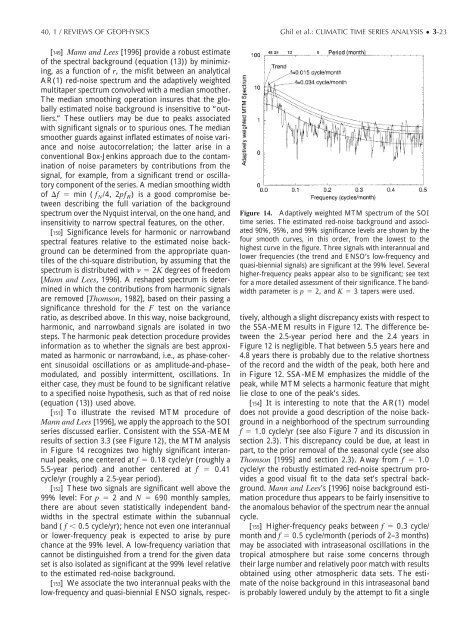advanced spectral methods for climatic time series - Atmospheric ...
advanced spectral methods for climatic time series - Atmospheric ...
advanced spectral methods for climatic time series - Atmospheric ...
You also want an ePaper? Increase the reach of your titles
YUMPU automatically turns print PDFs into web optimized ePapers that Google loves.
40, 1 / REVIEWS OF GEOPHYSICS Ghil et al.: CLIMATIC TIME SERIES ANALYSIS ● 3-23<br />
[149] Mann and Lees [1996] provide a robust estimate<br />
of the <strong>spectral</strong> background (equation (13)) by minimizing,<br />
as a function of r, the misfit between an analytical<br />
AR(1) red-noise spectrum and the adaptively weighted<br />
multitaper spectrum convolved with a median smoother.<br />
The median smoothing operation insures that the globally<br />
estimated noise background is insensitive to “outliers.”<br />
These outliers may be due to peaks associated<br />
with significant signals or to spurious ones. The median<br />
smoother guards against inflated estimates of noise variance<br />
and noise autocorrelation; the latter arise in a<br />
conventional Box-Jenkins approach due to the contamination<br />
of noise parameters by contributions from the<br />
signal, <strong>for</strong> example, from a significant trend or oscillatory<br />
component of the <strong>series</strong>. A median smoothing width<br />
of f min ( f N/4, 2pf R) is a good compromise between<br />
describing the full variation of the background<br />
spectrum over the Nyquist interval, on the one hand, and<br />
insensitivity to narrow <strong>spectral</strong> features, on the other.<br />
[150] Significance levels <strong>for</strong> harmonic or narrowband<br />
<strong>spectral</strong> features relative to the estimated noise background<br />
can be determined from the appropriate quantiles<br />
of the chi-square distribution, by assuming that the<br />
spectrum is distributed with 2K degrees of freedom<br />
[Mann and Lees, 1996]. A reshaped spectrum is determined<br />
in which the contributions from harmonic signals<br />
are removed [Thomson, 1982], based on their passing a<br />
significance threshold <strong>for</strong> the F test on the variance<br />
ratio, as described above. In this way, noise background,<br />
harmonic, and narrowband signals are isolated in two<br />
steps. The harmonic peak detection procedure provides<br />
in<strong>for</strong>mation as to whether the signals are best approximated<br />
as harmonic or narrowband, i.e., as phase-coherent<br />
sinusoidal oscillations or as amplitude-and-phase–<br />
modulated, and possibly intermittent, oscillations. In<br />
either case, they must be found to be significant relative<br />
to a specified noise hypothesis, such as that of red noise<br />
(equation (13)) used above.<br />
[151] To illustrate the revised MTM procedure of<br />
Mann and Lees [1996], we apply the approach to the SOI<br />
<strong>series</strong> discussed earlier. Consistent with the SSA-MEM<br />
results of section 3.3 (see Figure 12), the MTM analysis<br />
in Figure 14 recognizes two highly significant interannual<br />
peaks, one centered at f 0.18 cycle/yr (roughly a<br />
5.5-year period) and another centered at f 0.41<br />
cycle/yr (roughly a 2.5-year period).<br />
[152] These two signals are significant well above the<br />
99% level: For p 2 and N 690 monthly samples,<br />
there are about seven statistically independent bandwidths<br />
in the <strong>spectral</strong> estimate within the subannual<br />
band ( f 0.5 cycle/yr); hence not even one interannual<br />
or lower-frequency peak is expected to arise by pure<br />
chance at the 99% level. A low-frequency variation that<br />
cannot be distinguished from a trend <strong>for</strong> the given data<br />
set is also isolated as significant at the 99% level relative<br />
to the estimated red-noise background.<br />
[153] We associate the two interannual peaks with the<br />
low-frequency and quasi-biennial ENSO signals, respec-<br />
Figure 14. Adaptively weighted MTM spectrum of the SOI<br />
<strong>time</strong> <strong>series</strong>. The estimated red-noise background and associated<br />
90%, 95%, and 99% significance levels are shown by the<br />
four smooth curves, in this order, from the lowest to the<br />
highest curve in the figure. Three signals with interannual and<br />
lower frequencies (the trend and ENSO’s low-frequency and<br />
quasi-biennial signals) are significant at the 99% level. Several<br />
higher-frequency peaks appear also to be significant; see text<br />
<strong>for</strong> a more detailed assessment of their significance. The bandwidth<br />
parameter is p 2, and K 3 tapers were used.<br />
tively, although a slight discrepancy exists with respect to<br />
the SSA-MEM results in Figure 12. The difference between<br />
the 2.5-year period here and the 2.4 years in<br />
Figure 12 is negligible. That between 5.5 years here and<br />
4.8 years there is probably due to the relative shortness<br />
of the record and the width of the peak, both here and<br />
in Figure 12. SSA-MEM emphasizes the middle of the<br />
peak, while MTM selects a harmonic feature that might<br />
lie close to one of the peak’s sides.<br />
[154] It is interesting to note that the AR(1) model<br />
does not provide a good description of the noise background<br />
in a neighborhood of the spectrum surrounding<br />
f 1.0 cycle/yr (see also Figure 7 and its discussion in<br />
section 2.3). This discrepancy could be due, at least in<br />
part, to the prior removal of the seasonal cycle (see also<br />
Thomson [1995] and section 2.3). Away from f 1.0<br />
cycle/yr the robustly estimated red-noise spectrum provides<br />
a good visual fit to the data set’s <strong>spectral</strong> background.<br />
Mann and Lees’s [1996] noise background estimation<br />
procedure thus appears to be fairly insensitive to<br />
the anomalous behavior of the spectrum near the annual<br />
cycle.<br />
[155] Higher-frequency peaks between f 0.3 cycle/<br />
month and f 0.5 cycle/month (periods of 2–3 months)<br />
may be associated with intraseasonal oscillations in the<br />
tropical atmosphere but raise some concerns through<br />
their large number and relatively poor match with results<br />
obtained using other atmospheric data sets. The estimate<br />
of the noise background in this intraseasonal band<br />
is probably lowered unduly by the attempt to fit a single






